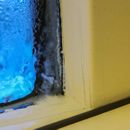Why are my windows wet?
4 year-old 2800 SF home in Duluth (zone 7A). Very tight construction, Well insulated etc. Using a Venmar HE1.8 HRV running full blast. We still have 1-2 inches of condensation and some ice along the bottom of our windows when the temp is <0F at night. (low-E H-windows). Is our HRV sized too small, or am I doing something wrong?
GBA Detail Library
A collection of one thousand construction details organized by climate and house part










Replies
Jeffrey,
The rules of physics are inviolable. When an indoor surface is cold enough -- when it is below the dewpoint -- moisture from the indoor air will condense on the cold surface.
There are only two ways to address this situation. You can either raise the temperature of your windows (this is usually done by adding storm windows, or by replacing the existing windows with better windows -- for example, triple-glazed windows with warm-edge spacers and well-insulated frames), or you can lower the indoor humidity. It's your choice.
If you want to lower the indoor relative humidity, you need to first measure it. If you don't have a hygrometer, I suggest that you buy one.
If your indoor relative humidity is high, then you have to either (a) identify the sources of your indoor moisture and mitigate them, or (b) increase the ventilation rate. (This last method only works during the winter.)
Your home may have a wet basement or wet crawl space.
For more information, see Rating Windows for Condensation Resistance.
Thanks Martin. We put in very good windows when we built. The architect recommended triple panes, but our builder talked me down to double pane because of cost and his report that triple paned low-e glass was structurally unsound (higher rate of inter-pane fogging and loss of seal). I will crank up the heat, and perhaps try a dehumidifier after checking the indoor relative humidity.
Jeff
Jeffrey :
condensation and ICE should be taken separately.
Condensation happens when a cold surface is at or below dew point as mentioned by Martin,
which if you look at dew point curves, changes in relation to the RH% .
Ice is another step down ... Ice means that this portion of window/frame is not only below dewpoint
( which could higher than 0c if your RH% is high enough ) is at or below ( clearly below on your picture ) 0c .
This should not be happening even with "so-so" recent windows.
You will first need to get a quality Hygrometer and measure RH% .
But you will also need to investigate the reason why your inner pane and frame section
is so cold.
Could you point out the manufacturer and model of your windows ? maybe the installed year ?
What is the temperature in the room where this picture was taken ?
RH% too high is easy to fix and not the biggest problem here now.
If your house is less than 10 years old ( or the windows are ) you clearly have a larger problem at hand.
Jeffrey,
Once you install a hygrometer, you'll be able to figure out if your indoor relative humidity (RH) is in a relatively safe range (35% or below during the winter is a good target).
If your indoor RH is high, you need to find the source of your moisture. In most homes, the first place to look is in your basement or crawl space. If these areas aren't damp, consider sources like fish tanks or houseplants.
Jeff,
Did you ever resolve your moisture problem? I'm getting ready to start a home like what you describe in Tower Minnesota. I also am looking at H-Windows. My plan is to go with triple pane and 12" high performance walls.
Steve
Jeff may have had high winter relative humidity, but it's also possible that (depending on the wall setup and window specs/install) double pane windows don't cut it in zone 7.
We have better than average windows (Alpen 525, approx R5) in zone 6, they are outie windows in a 12" double stud wall, well air sealed, spray foam in rough openings, and our winter relative humidity is in the safe range (25-35%). On nights towards 0f, we get small amounts of condensation on outer edges of the glass. On nights more towards -10f to -20f, this condensation can freeze up. The condensation is pretty easy to deal with in the morning, just a quick wipe with a towel...the ice/frost is more annoying. I think what we are seeing is mostly because the windows are installed on the cold section of a thick wall.
Steve, I would definitely go with the best triple pane windows you can afford and might not be a bad idea to go fiberglass/PVC instead of wood. Installing the windows in the middle or inside of the wall would keep them in a warmer section.
Steve: I agree with Brian, that in a cold climate, you really need good windows. We have a big wall of windows in our zone 6 house that consists of six panels (2 open, 4 fixed) that measures about 11'x11' overall. The windows are triple pane, about R8. Even when it goes below zero, we never have a drop of condensation. The indoor RH in winter is typically about 35-40%.